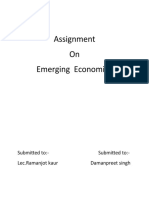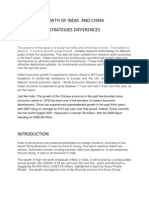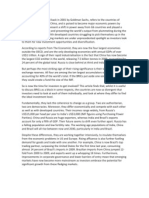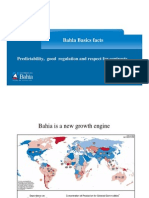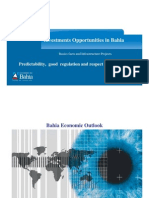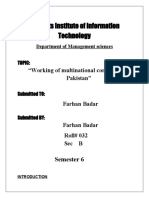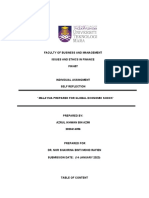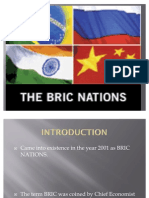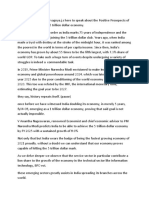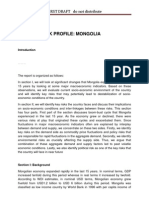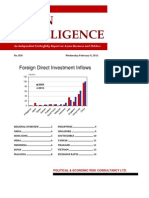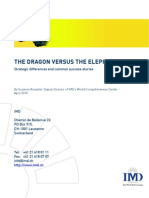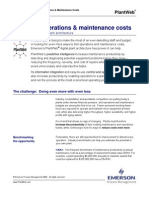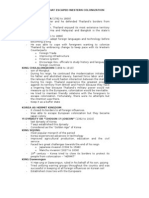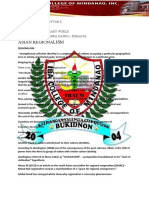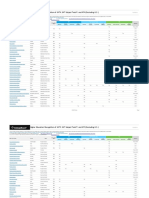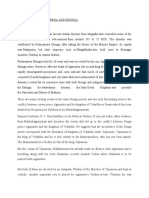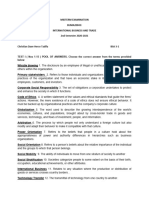The Best Countries For Long
The Best Countries For Long
Uploaded by
Nam SanchunCopyright:
Available Formats
The Best Countries For Long
The Best Countries For Long
Uploaded by
Nam SanchunOriginal Title
Copyright
Available Formats
Share this document
Did you find this document useful?
Is this content inappropriate?
Copyright:
Available Formats
The Best Countries For Long
The Best Countries For Long
Uploaded by
Nam SanchunCopyright:
Available Formats
The Best Countries for Long-Term Growth
Economic Growth Through 2050
Worries over the European debt crisis, a slow recovery in the U.S. and fears over a "hard landing" for Chinas economy have left global investors searching for new markets for their money. For long-term investors that means identifying economies that have strong growth prospects driven by advantages such as demographics, natural resources or geography. The following is a list of the 10 countries with the best prospects for long-term growth. It's based on a report from HSBC titled "The World in 2050," which forecasts what the economic landscape will look like over the next 40 years. Some of the economies are already known as economic powerhouses, while others may come as a surprise. The ranking includes some of the world's fastest-growing economies as well as those that will have the largest gross domestic product in absolute size by 2050. Excluded are economies that are projected to be less than $400 billion in GDP by 2050. The 2010 and projected 2050 GDP numbers are from the HSBC report and are based on constant U.S. dollar exchange rate in 2000. We calculated the annual average growth rates over the 40-year period based on figures in the report. Click ahead to find out which countries offer investors the best growth prospects in the next few decades.
By Ansuya Harjani Posted 15 Feb 2012
10. Algeria
Projected annual growth: 5% 2010 GDP: $76 billion* 2050 projected GDP: $538 billion Algeria, endowed with Africas third-largest proven oil reserves, is one of the richest countries on the continent, and its wealth appears likely to grow further in the coming decades. Oil reserves of 12 billion barrels have played a key role in luring foreign energy companies, including Anadarko and A.P. Moller-Maersk to the country. Petroleum products, the backbone of the economy, account for 95 percent of Algerias exports, according to the International Monetary Fund. Revenues from its commodities exports have allowed Algerias government to accumulate large savings in an oil stabilization fund, estimated to be worth $55 billion, which helped shield the economy from the fall in energy prices in 2009.
An acceleration of household consumption and government fiscal expansion has also helped to boost growth in recent years. In 2009, President Abdelaziz Bouteflika announced a five-year plan to increase government spending from $120 billion to $150 billion to improve national infrastructure, create 3 million jobs, and build 1 million new homes. Although the country has favorable demographics on its side with more than half the population under age 35 the country faces high levels of youth unemployment. Over 20 percent of those in the 16-24 age bracket are unemployed, and Algeria has seen several protests during last years Arab Spring. * Based on 2000 U.S. dollars 9. China
Projected annual growth: 5.1% 2010 GDP: $3.511 trillion* 2050 projected GDP: $25.334 trillion It may be no surprise that China, the current engine of global growth, is set to be one of the fastest growing economies over the next four decades. But what is noteworthy is that the size of mainland economy, which is currently one-third that of the United States, is expected to grow more than seven-fold to overtake the U.S. by 2050. It is no wonder that foreign companies across all sectors are flocking to China to set up shop and capitalize on its growth. The country is a leading recipient of foreign
direct investment, receiving $116 billion in 2011, according to Chinas Commerce Ministry. Growing wealth among Chinese firms has also led to an increasing amount of outward foreign direct investment increasing the countrys influence on the world economy. In 2011 alone, China invested in 1,392 overseas projects in 132 countries, totaling $332 billion . Dubbed the worlds factory, Chinas economy has been largely fueled by its export sector. However, the countrys latest five-year plan aims to shift the economys focus to the development of its internal market. One way it plans to do so is by increasing the spending power of its 1.36 billion population by spurring job creation and implementing minimum-wage requirements. The government recently pledged to raise minimum wages by 13 percent a year through 2015 and launch measures to generate 45 million new jobs. * Based on 2000 U.S. dollars 8. Egypt
Projected annual growth: 5.1% 2010 GDP: $160 billion* 2050 projected GDP: $1.165 trillion Egypt, the Arab world's second largest economy and most populous nation, is a hub for trade routes between Africa, Europe, and Asia due to its strategic location.
The economy relies heavily on agriculture and petroleum exports as well as tourism. Home to one of the most-visited attractions in the world, the Pyramids of Giza, Egypts tourism sector employs 10 percent of the countrys workforce and accounts for 11 percent of GDP . The economy, however, is among the most fragile in this ranking due to Egypt's political uncertainty. Violent anti-government protests that began in January 2011 and helped topple the government of Hosni Mubarak have continued into 2012. According to the investment bank Credit Agricole, each day of demonstrations costs the economy $310 million. The tourism and manufacturing sectors and foreign direct investment into the country have been most affected by the unrest. FDI, for example, fell 93 percent during the first nine months of 2011, according to central bank data. While the political uncertainty is clouding the outlook for the economy, some economists believe the revolution, if successful, could bring about positive change that would far outweigh recent short-term losses, including reducing corruption and improving the distribution of wealth. * Based on 2000 U.S. dollars 7. Vietnam
Projected annual growth: 5.2% 2010 GDP: $59 billion* 2050 projected GDP: $451 billion
As the worlds second-largest exporter of rice, agriculture has been a pillar of Vietnams economy. But this is rapidly changing as the government moves to liberalize and diversify the economy. While, state-owned enterprises contribute 40 percent of the countrys GDP, overseas investment has been on the rise since the country was granted entrance into the World Trade Organization in 2007. Vietnams low-cost manufacturing base has attracted a wave of foreign money, particularly by retail clothing and technology firms, looking for a cheaper alternative to China. Intel, the first international technology company to make a major investment in the country six years ago, has helped raise Vietnams profile as an investment destination. A long list of companies including Samsung, Canon and Foxconn have followed, investing millions into developing manufacturing operations in the country. Analysts say this is helping to lay the foundation for Vietnam to become Asias next big electronics manufacturing hub. Vietnams rapid growth in the recent years, however, hasnt come without a price. The countrys pro-growth policies have resulted in record inflation. In 2011, consumer prices soared over 18 percent, doubling the rate in 2010. * Based on 2000 U.S. dollars 6. Malaysia
Projected annual growth: 5.3 percent 2010 GDP: $146 billion* 2050 projected GDP: $1.16 trillion Malaysia, Southeast Asias third-largest economy, also has one of the best economic records in the region, growing by an average 6.5 percent per year from its independence in 1957 to 2005, according to the CIA World Factbook. Once dependent on mining and agricultural exports such as tin and rubber, Malaysia now boasts a diversified economy a key factor in helping the country bounce back from the 1997 Asian financial crisis faster than its peers. It is now one of the world's largest exporters of semiconductor devices, electrical goods and solar panels, and is a global center for Islamic banking. The economy is also supported by a growing domestic consumer base, which the government hopes to boost even further in coming years. In 2010, the countrys prime minister unveiled a plan the New Economic Model aimed at more than doubling the per capita income in Malaysia by 2020. However, its not all rosy for the Southeast Asian economy, which is facing an outflow of human capital to more developed countries. An increasing number of Malaysians are looking to countries such as Singapore and Australia for better education and career opportunities. The skills shortage is hurting the countrys ability to attract more high-tech, petrochemical and engineering companies from abroad, according to the Malaysian International Chamber of Commerce and Industry.
* Based on 2000 U.S. dollars 5. Bangladesh
Projected annual growth: 5.5% 2010 GDP: $78 billion* 2050 projected GDP: $673 billion Bangladesh is the poorest country to make the ranking, with around 30 percent of the population living below the international poverty line, according to government officials. That equates to 45 million people living on $1.25 a day. But, things will be very different in 40 years, according to HSBC, which says GDP per capita will increase six fold between now and then. One of the countrys biggest assets is its growing low-cost labor force. That has attracted overseas investors such as JC Penney, Wal-Mart, H&M, Marks & Spencer and Zara which have pumped money into the countrys manufacturing sector. Ready-made garment manufacturing, now a critical part of the economy, employs 3.5 million workers and makes up more than 75 percent of the Bangladeshs exports. To encourage more investment in the sector, the government launched an initiative to develop garment villages across the country. Consulting firm McKinsey believes Bangladesh could fill the low-value manufacturing gap as Chinese manufacturers moves up the value chain.
Bangladeshs onshore and offshore gas reserves are also seen as a potential source of wealth. Last year, energy giants including Chevron and Santos, poured hundreds of millions of dollars into searching for gas in the largely unexplored deep waters of the Bay of Bengal. * Based on 2000 U.S. dollars 4. India
Projected annual growth: 5.5% 2010 GDP: $960 billion* 2050 projected GDP: $8.165 trillion India, South Asias economic powerhouse, is forecast to leap six spots to become the worlds third-largest economy in absolute terms by 2050, replacing Japan. Unlike regional rival China, Asias rising elephant has experienced robust growth only since the 1990s following the governments move to deregulate the economy and attract more foreign investment. The economic reforms and favorable demographics have enabled India to play catch-up and emerge as one of the frontrunners in Asia. Indias young and growing population offers a large workforce and booming consumer market factors that are regarded as vital drivers of long-term growth. The countrys thriving middle class, a key source of domestic demand, stands at
approximately 300 million and is approaching the entire population of the United States. These factors have positioned India as a preferred destination for foreign investment in the region. The latest entrants into the market include coffee chain giant Starbucks and global online shopping giant Amazon. In the first 11 months of 2011, foreign direct investment totaled $50.81 billion, up 13 percent from the previous year, according to Ernst & Young. * Based on 2000 U.S. dollars 3. Peru
Projected annual growth: 5.5% 2010 GDP: $85 billion* 2050 projected GDP: $735 billion Referred to as South Americas rising star, Peru is enjoying its longest economic expansion on record, averaging 7 percent growth from 2003-2010. Growth is expected to remain robust in coming decades, with HSBC forecasting the country to jump 20 places to become the 26 th largest economy by 2050. The Andean nation, which was ravaged by a 20-year armed conflict with Maoist Shining Path guerrillas between 1980-2000, has successfully managed to bounce back thanks to a leap in private investment. The countrys pro-business government has played a key role in this, encouraging decentralization and greater transparency.
As the worlds second-largest producer of copper and silver, Peru has attracted substantial investments in mining, which accounts for 60 percent of its exports. The resources sector has attracted more than $18 billion in investment, mostly foreign, over the last 15 years. But the mining boom has not come without resistance. Authorities have faced opposition from Perus indigenous groups in the Amazon region and Andean mountains, who argue that the mining projects are wiping out their ancestral lands. Theres also a large, unwanted contributor to the economy: drug trafficking. In 2010, Peru overtook Colombia as the leading producer of coca leaf, the source for cocaine. According to the AFP, drug trafficking generated $22 billion in 2009, nearly 17 percent of Peru's gross domestic product. * Based on 2000 U.S. dollars 2. Ukraine
Projected annual growth: 6% 2010 GDP: $45 billion* 2050 projected GDP: $462 billion The economy of Ukraine is forecast to increase 10 fold over the next 40 years, outperforming its European peers.
The former Soviet republic is well endowed with natural resources, including highquality agricultural land and mineral deposits. It also has the world's largest manganese-ore fields, according to the Organization for Economic Cooperation and Development. The abundance of other mineral resources, including coal and iron, has allowed it to become one of the largest refiners of metallurgical products in Eastern Europe. Demand for Ukraines top export, steel, and robust domestic consumption helped by rising pension and wages, led to an annual average growth rate of 7.5 percent for the economy between 2001-2008, according to the OECD. However, the country was severely hit by the global economic downturn, which cut FDI inflows by more than half and led to a 15 percent contraction in GDP during 2009. In 2010, however, the country returned to positive growth, boosted by a recovery in exports. The value of Ukraines exports for 2010 was $52 billion, representing a 30 percent increase over the previous year, according to the CIA World Fact Book. In addition to access to resources, one of Ukraines other competitive advantages has been its focus on education and developing human capital, which HSBC believes will be key for driving growth in coming decades. The country boasts a near 100 percent literacy rate and has a well-qualified labor force an important factor for attracting investment. * Based on 2000 U.S. dollars 1. Philippines
Projected annual growth: 7% 2010: $112 billion* 2050 projected GDP: $1.688 trillion The Philippines has one of the fastest-growing populations in Asia. The population is set to jump by almost 70 percent over the next 40 years, and HSBC believes the combination of its powerful demographics and strong fundamentals will drive the economy to become the worlds 16th largest by 2050. That would mark a jump of 27 places from its current ranking of 43. The country is one of the worlds largest exporters of labor, with over 9 million Filipinos working abroad, according to the latest data from the Commission of Filipinos Overseas. In 2010, almost $19 billion was sent back to the Philippines as remittances from Filipinos working abroad. More recently, the countrys fast-developing business process outsourcing (BPO) industry has helped keep some of the workforce from leaving the country. Already 350,000 Filipinos are estimated to work in call centers, compared with 330,000 Indians, according to the Contact Center Association of the Philippines. The industry is projected to provide more than 1 million jobs within two years. The economys focus on the services sector and domestic consumption, as well as a lower exposure to global financial markets, helped it to escape a recession following the 2008 global financial crisis. * Based on 2000 U.S. dollars
You might also like
- Speech by Head of HIP Highly Immersive Programme For The Launching CeremonyDocument2 pagesSpeech by Head of HIP Highly Immersive Programme For The Launching CeremonyAmir Amin100% (14)
- Refinery Plant OperationsDocument295 pagesRefinery Plant Operationsluv_y_kush357578% (9)
- Assignment On Emerging EconomiesDocument4 pagesAssignment On Emerging EconomiessinghdamanNo ratings yet
- Economic Growth of India and ChinaDocument4 pagesEconomic Growth of India and Chinaswatiram_622012No ratings yet
- BricDocument3 pagesBricManhao TangNo ratings yet
- China Economy Case StudyDocument8 pagesChina Economy Case StudyShem W Lyngdoh100% (1)
- China Case StudyDocument3 pagesChina Case Studypq8zkq2xycNo ratings yet
- Looking For Information On Economic Development of India and ChinaDocument18 pagesLooking For Information On Economic Development of India and Chinayoan_rahmiNo ratings yet
- ASEAN PhilippinesDocument39 pagesASEAN PhilippinesleshamunsayNo ratings yet
- TutorialDocument4 pagesTutorialDibya sahaNo ratings yet
- The World Order in 2050Document29 pagesThe World Order in 2050Carnegie Endowment for International Peace100% (1)
- Briefing 67 China Economic Review 2010Document30 pagesBriefing 67 China Economic Review 2010Jocel M. SinguaNo ratings yet
- Oportunidades de Investimentos Na Bahia - EXPO Xangai RT 29092010Document46 pagesOportunidades de Investimentos Na Bahia - EXPO Xangai RT 29092010Romeu TemporalNo ratings yet
- Uem 3Document13 pagesUem 3Manan DesaiNo ratings yet
- Bahia Basics Facts: Predictability, Good Regulation and Respect For ContractsDocument50 pagesBahia Basics Facts: Predictability, Good Regulation and Respect For ContractsRomeu TemporalNo ratings yet
- Drivers of International BusinessDocument4 pagesDrivers of International Businesskrkr_sharad67% (3)
- The Vietnam Economic Success Story A Model For North KoreaDocument3 pagesThe Vietnam Economic Success Story A Model For North KoreaduchoangNo ratings yet
- Nominal GDPDocument9 pagesNominal GDPJyoti Ranjan TripathyNo ratings yet
- Brics at A GlanceDocument1 pageBrics at A GlanceCityPressNo ratings yet
- Africa The Worlds Next Growth FrontierDocument15 pagesAfrica The Worlds Next Growth FrontierTinashe MpasiriNo ratings yet
- India's Bubble Economy Headed Towards Iceberg?: CategorizedDocument6 pagesIndia's Bubble Economy Headed Towards Iceberg?: CategorizedMonisa AhmadNo ratings yet
- Reading Extracts - Vietnam's EconomyDocument5 pagesReading Extracts - Vietnam's EconomyAkuno HanaNo ratings yet
- Intro GlobalDocument4 pagesIntro Globaljoyce nacuteNo ratings yet
- PE in China EY May2011Document20 pagesPE in China EY May2011pareshsharmaNo ratings yet
- BD Eco SituDocument37 pagesBD Eco SituMinhaz Hossain OnikNo ratings yet
- Rehanshu Vij-DC-K-12735Document5 pagesRehanshu Vij-DC-K-12735RehanshuVijNo ratings yet
- " Are Developing Nations Really Developing" - Fact or Illusion?Document20 pages" Are Developing Nations Really Developing" - Fact or Illusion?Rahul GoyalNo ratings yet
- Globalization and Its Impact On IndiaDocument3 pagesGlobalization and Its Impact On IndiaJananee Rajagopalan100% (1)
- Causes For Slow Economic Growth in IndiaDocument10 pagesCauses For Slow Economic Growth in IndiaThakur Shobhit SinghNo ratings yet
- CommentDocument2 pagesCommentshanikayani_20103758No ratings yet
- Investments Opportunities in Bahia: Predictability, Good Regulation and Respect For ContractsDocument49 pagesInvestments Opportunities in Bahia: Predictability, Good Regulation and Respect For ContractsRomeu TemporalNo ratings yet
- AEE Study NotesDocument41 pagesAEE Study Notesyie_793No ratings yet
- Comsats Institute of Information Technology: "Working of Multinational Companies in Pakistan"Document15 pagesComsats Institute of Information Technology: "Working of Multinational Companies in Pakistan"Farhan Badar SiddiquiNo ratings yet
- Emerging China: 2020 Report Published in 1997. Although Most of Its Exports Were Once Directed Toward The EuropeanDocument5 pagesEmerging China: 2020 Report Published in 1997. Although Most of Its Exports Were Once Directed Toward The EuropeanTUSHER147No ratings yet
- Economy of BangladeshDocument32 pagesEconomy of BangladeshMamun BappyNo ratings yet
- Economic Indicators of ChinaDocument9 pagesEconomic Indicators of ChinaNishkarshNo ratings yet
- Economic Crisis in PakistanDocument14 pagesEconomic Crisis in PakistantufailNo ratings yet
- Ib - 1Document12 pagesIb - 1Rakibur Rahman SiddiqueNo ratings yet
- Azrul Ikhwan Bin Azmi (2020414356) - Self ReflectionDocument8 pagesAzrul Ikhwan Bin Azmi (2020414356) - Self ReflectionAZRUL IKHWAN AZMINo ratings yet
- Part X - The Dominant Causes of The Credit Crisis: The Threat of China's Bulging ExportsDocument16 pagesPart X - The Dominant Causes of The Credit Crisis: The Threat of China's Bulging ExportsAnchorageInvestmentsNo ratings yet
- What Major Industry Has Empowered China in Foreign Trade?Document6 pagesWhat Major Industry Has Empowered China in Foreign Trade?Umair AijazNo ratings yet
- Kingdom Defies Global CrisisDocument1 pageKingdom Defies Global CrisisChou ChantraNo ratings yet
- BRICSDocument20 pagesBRICSShahid Khan50% (4)
- Journey To A 5 Trillion Dollar EconomyDocument4 pagesJourney To A 5 Trillion Dollar EconomySarvagnya JatadharanNo ratings yet
- Effects of China Slowdown On IndiaDocument4 pagesEffects of China Slowdown On IndiaPritesh DesaiNo ratings yet
- Deficit Balance of Payments, Causes and ControlDocument8 pagesDeficit Balance of Payments, Causes and ControlshahrozeNo ratings yet
- China Essay Final HSCDocument3 pagesChina Essay Final HSCAnjali PatelNo ratings yet
- The Global Economy Report - DraftDocument9 pagesThe Global Economy Report - Draftmaddie.george020406No ratings yet
- Report On Risk ProfileDocument16 pagesReport On Risk ProfilehuraldayNo ratings yet
- Article On Pakistan Economy: Taruj TariqDocument29 pagesArticle On Pakistan Economy: Taruj TariqTeeJyy0% (1)
- BricDocument14 pagesBricAnanth RamanNo ratings yet
- QatarDocument21 pagesQatarCyrus Rogie Ramos BatayanNo ratings yet
- China Inside Out: China Going Global: Key TrendsDocument40 pagesChina Inside Out: China Going Global: Key TrendsTon ChockNo ratings yet
- (Political and Economic Risk Consultancy, Ltd. - PEDocument14 pages(Political and Economic Risk Consultancy, Ltd. - PEFal Gain100% (1)
- Za Ethiopia Growth Miracle July2014Document22 pagesZa Ethiopia Growth Miracle July2014DavidNo ratings yet
- Iqtisadi Eng Oct2012 RIVLIN Arab Economic WinterDocument6 pagesIqtisadi Eng Oct2012 RIVLIN Arab Economic WinterMosheDayanCenterNo ratings yet
- Assignment On INDIAN EconomyDocument16 pagesAssignment On INDIAN Economyprithvi yadavNo ratings yet
- Key Issues For The Global Economy and Construction in 2011: Program, Cost, ConsultancyDocument14 pagesKey Issues For The Global Economy and Construction in 2011: Program, Cost, ConsultancyUjjal RegmiNo ratings yet
- TC033-10 - Dragon Vs ElephantDocument7 pagesTC033-10 - Dragon Vs ElephantSuzanne Rosselet-MccauleyNo ratings yet
- Economy of Vietnam: Đ I M I Highly-CentralizedDocument8 pagesEconomy of Vietnam: Đ I M I Highly-CentralizedViet TamNo ratings yet
- Current Investment in the United Kingdom: Part One of The Investors' Guide to the United Kingdom 2015/16From EverandCurrent Investment in the United Kingdom: Part One of The Investors' Guide to the United Kingdom 2015/16No ratings yet
- Finance in Africa: Navigating the financial landscape in turbulent timesFrom EverandFinance in Africa: Navigating the financial landscape in turbulent timesNo ratings yet
- CO System Operation and Maintenance: Facilities, Instructions, Standards, and Techniques Volume 5-12Document47 pagesCO System Operation and Maintenance: Facilities, Instructions, Standards, and Techniques Volume 5-12ThếSơnNguyễnNo ratings yet
- Materials of Construction, Operation and Maintenance in The Chemical Process IndustriesDocument37 pagesMaterials of Construction, Operation and Maintenance in The Chemical Process IndustriesNam SanchunNo ratings yet
- SAmpling and Records KeepingDocument131 pagesSAmpling and Records KeepingSundarapandiyan SundaramoorthyNo ratings yet
- Plant We Bops MaintDocument18 pagesPlant We Bops MaintNam SanchunNo ratings yet
- Operation and Maintenance of Chillers: TopicsDocument10 pagesOperation and Maintenance of Chillers: TopicsMohammed AbbasNo ratings yet
- Sew Safety Manual 081606Document20 pagesSew Safety Manual 081606Nam SanchunNo ratings yet
- WM WHP IO 02A AllDocument126 pagesWM WHP IO 02A AllNam Sanchun100% (1)
- Handbook - RefrigerationDocument67 pagesHandbook - Refrigerationmnt617685% (13)
- Custom Fuel Tank Design GuideDocument6 pagesCustom Fuel Tank Design GuidesyammohansNo ratings yet
- Đọc Thử - Simple Writing Lớp 4Document9 pagesĐọc Thử - Simple Writing Lớp 4Khánh Ngọc LêNo ratings yet
- Chapter 4 Forum Q#7Document1 pageChapter 4 Forum Q#7BARRENT CASPEAN GIL AGUDANo ratings yet
- 110 Islamic Travelogue 1427 8 - Imran HoseinDocument1 page110 Islamic Travelogue 1427 8 - Imran Hoseinspeed2kxNo ratings yet
- Philippine Planning HistoryDocument38 pagesPhilippine Planning HistoryMia CabotageNo ratings yet
- Nhung Nguoi Thich DuaDocument81 pagesNhung Nguoi Thich Duaweaone000No ratings yet
- Asian Countries That Escaped Western ColonizationDocument2 pagesAsian Countries That Escaped Western ColonizationJiordan SimonNo ratings yet
- Arab Empire and The CaliphatesDocument29 pagesArab Empire and The Caliphatesaeriel achuNo ratings yet
- After Tamerlane: The Rise and Fall of Global Empires, 1400-2000Document25 pagesAfter Tamerlane: The Rise and Fall of Global Empires, 1400-2000Shantalle KimNo ratings yet
- Historical Background of Khilafat MovementDocument2 pagesHistorical Background of Khilafat MovementasadNo ratings yet
- Group 2 Hardcopy of The Report Maam AprilDocument4 pagesGroup 2 Hardcopy of The Report Maam AprilRoyvan AlimaongNo ratings yet
- Story Telling EnglishDocument2 pagesStory Telling EnglishSyahrizal Lutfian100% (1)
- Higher Education Recognition of SAT®, SAT Subject Tests™, and AP® (Excluding U.S.)Document19 pagesHigher Education Recognition of SAT®, SAT Subject Tests™, and AP® (Excluding U.S.)Sanket PatilNo ratings yet
- The Battle of Vidharbha and ShungaDocument3 pagesThe Battle of Vidharbha and ShungaParas GuptaNo ratings yet
- Publication List From KKRDocument13 pagesPublication List From KKRLucasNo ratings yet
- Burj Khalifa ImportantDocument42 pagesBurj Khalifa ImportantAnonymous ep7LE5ZdP5No ratings yet
- Geography of Pakistan MCQs - Pakistan Studies - Affairs Notes (Set-I)Document10 pagesGeography of Pakistan MCQs - Pakistan Studies - Affairs Notes (Set-I)Umar FarooqNo ratings yet
- Six Point + Agartala Conspiracy Case .Docx - LNKDocument13 pagesSix Point + Agartala Conspiracy Case .Docx - LNKanisNo ratings yet
- Asal Usul LipatkainDocument4 pagesAsal Usul LipatkainRahmeli Ummu Hilyatul HusnaNo ratings yet
- Midterm Examination IbtDocument7 pagesMidterm Examination IbtChristen HerceNo ratings yet
- Kurdish PopulationDocument20 pagesKurdish PopulationGiovanni C. LorussoNo ratings yet
- Arch 18 - Critical Regionalism and Its Philippine ContextDocument2 pagesArch 18 - Critical Regionalism and Its Philippine ContextKevin Throy Corpuz Elpedes100% (2)
- Formation of Muslim League in 1906Document2 pagesFormation of Muslim League in 1906ARZOO80% (5)
- 1 - Why Study Religion Introduction E18Document3 pages1 - Why Study Religion Introduction E18tijeat berryNo ratings yet
- The Great Wall of ChinaDocument2 pagesThe Great Wall of ChinaMaria DanNo ratings yet
- Asia Continent GKDocument34 pagesAsia Continent GKVikram SrinivasNo ratings yet
- 02 Chapter 2-19th Cent-World, Spain & PhilsDocument27 pages02 Chapter 2-19th Cent-World, Spain & PhilsMicheleNo ratings yet
- Asian Values Paper For ScribDocument12 pagesAsian Values Paper For ScribRenante AvergonzadoNo ratings yet
- East Pakistan Provincial Elections in 1954 & The United FrontDocument16 pagesEast Pakistan Provincial Elections in 1954 & The United FrontTaef Hossain 1531416630No ratings yet
- Separation of East Pakistan 1971Document3 pagesSeparation of East Pakistan 1971Muhammad Abu Turab YeetNo ratings yet


